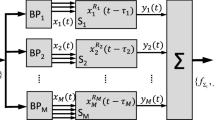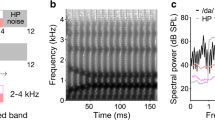Abstract
This study aimed to validate the existence and investigate the characteristics of the transient responses from conventional auditory steady-state responses (ASSRs) using deconvolution methods capable of dealing with amplitude modulated (AM) stimulation. Conventional ASSRs to seven stimulus rates were recorded from 17 participants. A deconvolution method was selected and modified to accommodate the AM stimulation. The calculated responses were examined in terms of temporal features with respect to different combinations of stimulus rates. Stable transient responses consisting of early stage brainstem responses and middle latency responses were reconstructed consistently for all rate combinations, which indicates that the superposition hypothesis is applicable to the generation of approximately 80 Hz ASSRs evoked by AM tones (AM-ASSRs). The new transient responses are characterized by three pairs of peak-troughs named as n0p0, n1p1, and n2p2 within 40 ms. Compared with conventional ABR-MLRs, the n0p0 indicates the first neural activity where p0 might represent the main ABR components; the n1 is the counterpart of N10; the p2 is corresponding to the robust Pa at about 30 ms; the p1 and n2 are absent of real counterparts. The peak–peak amplitudes show a slight decrease with increasing stimulation rate from 75 to 95 Hz whereas the peak latencies change differently, which is consistent with the known rate-effect on AEPs. This is direct evidence for a transient response derived from AM-ASSRs for the first time. The characteristic components offer insight into the constitution of AM-ASSRs and may be promising in clinical applications and fundamental studies.




Similar content being viewed by others
Data Availability and Material
Data and material are available in figshare, https://doi.org/10.6084/m9.figshare.14775975.
Code Availability
Codes of software are available in figshare, https://doi.org/10.6084/m9.figshare.14775975.
Change history
07 October 2021
This article has been corrected to include the statement “Tao Wang and Yuner Chen are both first authors with equal contributions” in the PDF.
07 October 2021
A Correction to this paper has been published: https://doi.org/10.1007/s10162-021-00818-y
Abbreviations
- ABR:
-
Auditory brainstem response
- AEP:
-
Auditory evoked potential
- AM:
-
Amplitude modulation
- AM-ASSR:
-
ASSR evoked by AM pure tone
- AM-tAEP:
-
Reconstructed tAEP from AM-ASSR and considered as the response elicited by one sound element in AM tone
- ASSR:
-
Auditory steady-state response
- CLAD:
-
Continuous loop averaging deconvolution
- click-tAEP:
-
Reconstructed tAEP from ASSR evoked by clicks at high rates and considered as the response evoked by one click stimulus in a click sequence at high repetition rates
- EEG:
-
Electroencephalograph
- ISI:
-
Interstimulus interval
- MLR:
-
Middle latency response
- MLS:
-
Maximum length sequence
- MSAD:
-
Multirate steady-state averaging deconvolution
- SNR:
-
Signal-to-noise ratio
- SVD:
-
Singular value decomposition, a mathematical tool
- tAEP:
-
Transient AEP
References
Alhussaini K, Bohórquez J, Delgado RE, Özdamar Ö (2018) Auditory brainstem, middle and late latency responses to short gaps in noise at different presentation rates. Int J Audiol 57:399–406
Bardy F, Dillon H, Van Dun B (2014) Least-squares deconvolution of evoked potentials and sequence optimization for multiple stimuli under low-jitter conditions. Clin Neurophysiol 125:727–737
Beattie RC, Boyd RL (1985) Early/middle evoked potentials to tone bursts in quiet, white noise and notched noise. Audiology 24(6):406–419
Beattie RC, Moretti M, Warren V (1984) Effects of rise-fall time, frequency, and intensity on the early/middle evoked response. J Speech Hear Disord 49(2):114–127
Bohórquez J, Özdamar Ö (2008) Generation of the 40-Hz auditory steady-state response (ASSR) explained using convolution. Clin Neurophysiol 119:2598–2607
Burkard RF, Finneran JJ, Mulsow J (2017) The effects of click rate on the auditory brainstem response of bottlenose dolphins. J Acoust Soc Am 141:3396–3406
Burkard R, Finneran JJ, Mulsow J (2018) Comparison of maximum length sequence and randomized stimulation and averaging methods on the bottlenose dolphin auditory brainstem response. J Acoust Soc Am 144:308–318
Delgado RE, Özdamar Ö (2004) Deconvolution of evoked responses obtained at high stimulus rates. J Acoust Soc Am 115:1242–1251
Dykstra AR, Burchard D, Starzynski C, Riedel H, Rupp A, Gutschalk A (2016) Lateralization and binaural interaction of middle-latency and late-brainstem components of the auditory evoked response. J Assoc Res Otolaryngol 17:357–370
Eysholdt U, Schreiner C (1982) Maximum length sequences – a fast method for measuring brain-stem-evoked responses. Audiology 21:242–250
Finneran JJ, Mulsow J, Houser DS, Burkard RF (2018) Effects of noise burst rise time and level on bottlenose dolphin (Tursiops truncatus) auditory brainstem responses. J Acoust Soc Am 143:2914–2921
Funasaka S, Ito S (1986) Stimulus duration and waves of auditory brainstem response. Audiology 25(3):176–183
Galambos R, Makeig S, Talmachoff PJ (1981) A 40-Hz auditory potential recorded from the human scalp. Proc Natl Acad Sci USA 78:2643–2647
Guérin-Dugué A, Roy RN, Kristensen E, Rivet B, Vercueil L, Tcherkassof A (2018) Temporal dynamics of natural static emotional facial expressions decoding: a study using event- and eye fixation-related potentials. Front Psychol 9:1190–1209
Hall JW (1991) Waveform analysis. Hall JW Handbook of auditory evoked response. Allyn & Bacon, Boston, pp 221–260
Hansen PC (1987) The truncated SVD as a method for regularization. BIT Numer Math 27:534–553
Herdman AT, Lins O, Roon PV, Stapells DR, Scherg M, Picton TW (2002) Intracerebral sources of human auditory steady-state responses. Brain Topogr 15:69–86
Holmes E, Purcell DW, Carlyon RP, Gockel HE, Johnsrude IS (2018) Attentional modulation of envelope-following responses at lower (93–109 Hz) but not higher (217–233 Hz) Modulation Rates. J Assoc Res Otolaryngol 19:83–97
Holt F, Özdamar Ö (2016) Effects of rate (0.3-40/s) on simultaneously recorded auditory brainstem, middle and late responses using deconvolution. Clin Neurophysiol 127:1589–1602
Hotelling H (1931) The Generalization of Student’s Ratio. Ann Math Statist 2:360–378
Jewett DL, Caplovitz G, Baird B, Trumpis M, Olson MP, Larson-Prior LJ (2004) The use of QSD (q-sequence deconvolution) to recover superposed, transient evoked-responses. Clin Neurophysiol 115:2754–2775
Johnston PR, Gulrajani RM (2000) Selecting the corner in the L-curve approach to Tikhonov regularization. IEEE Trans Biomed Eng 47:1293–1296
Jones R, Finneran JJ, Mulsow J, Burkar RF (2019) Effects of stimulus cosine onset properties on bottlenose dolphin (Tursiops truncatus) auditory brainstem responses. J Acoust Soc Am 145:2994–3002
Kodera K, Hink RF, Yamada O, Suzuki JI (1979) Effects of rise time on simultaneously recorded auditory-evoked potentials from the early, middle and late ranges. Audiology 18:395–402
Korczak P, Smart J, Delgado R, Strobe TM, Bradford C (2012) Auditory steady-state responses. J Am Acad Audiol 23:146–170
Kowalski N, Depireux DA, Shamma SA (1996a) Analysis of dynamic spectra in ferret primary auditory cortex. I. Characteristics of single-unit responses to moving ripple spectra. J Neurophysiol 76(5):3503–3523
Kowalski N, Depireux DA, Shamma SA (1996b) Analysis of dynamic spectra in ferret primary auditory cortex. II. Prediction of unit responses to arbitrary dynamic spectra. J Neurophysiol 76(5):3524–3534
Lachowska M, Bohórquez J, Özdamar Ö (2012) Simultaneous acquisition of 80 Hz ASSRs and ABRs from quasi ASSRs for threshold estimation. Ear Hear 33(5):660–671
Lachowska M, Bohórquez J, Özdamar Ö, Niemczyk K (2016) Estimating audiometric thresholds using simultaneous acquisition of ASSR and ABR from QASSR in patients with sensorineural hearing loss. Int J Audiol 55(12):748–757
Lins OG, Picton PE, Picton TW, Champagne SC, Durieux-Smith A (1995) Auditory steady-state responses to tones amplitude-modulated at 80–110 Hz. J Acoust Soc Am 97:3051–3063
Luke R, De Vos A, Wouters J (2017) Source analysis of auditory steady-state responses in acoustic and electric hearing. Neuroimage 147:568–576
McNeer RR, Bohórquez J, Özdamar Ö (2009) Influence of auditory stimulation rates on evoked potentials during general anesthesia: relation between the transient auditory middle-latency response and the 40-Hz auditory steady state response. Anesthesiology 110:1026–1035
Özdamar Ö, Bohórquez J, Ray SS (2007) P(b)(P(1)) resonance at 40 Hz: effects of high stimulus rate on auditory middle latency responses (MLRs) explored using deconvolution. Clin Neurophysiol 118:1261–1273
Picton TW (2011) Human auditory evoked potentials. Plural, San Diego
Picton TW, Vajsar J, Rodriguez R, Campbell KB (1987) Reliability estimates for steady-state evoked potentials. Electroencephalogr Clin Neurophysiol 68:119–131
Suzuki T, Kobayashi K, Takagi N (1986) Effects of stimulus repetition rate on slow and fast components of auditory brain-stem responses. Electroencephalogr Clin Neurophysiol 65:150–156
Tan X, Fu Q, Yuan H, Ding L, Wang T (2017) Improved transient response estimations in predicting 40 Hz auditory steady-state response using deconvolution methods. Front Neurosci 11:697
Tan X, Peng X, Zhan CA, Wang T (2016) Comparison of auditory middle-latency responses from two deconvolution methods at 40 Hz. IEEE Trans Biomed Eng 63:1157–1166
Tawfik S, Musiek FE (1991) SN10 auditory evoked potential revisited. Am J Otol 12:179–183
Valderrama JT, Torre A, Alvarez IM, Segura JC, Thornton ARD, Sainz M, Vargas JL (2014) Auditory brainstem and middle latency responses recorded at fast rates with randomized stimulation. J Acoust Soc Am 136:3233–3248
Wang T, Zhan C, Yan G, Bohórquez J, Özdamar Ö (2013) A preliminary investigation of the deconvolution of auditory evoked potentials using a session jittering paradigm. J Neural Eng 10:26023–26036
Xu ZM, De Vel E, Vinck B, Van Cauwenberge PB (1995) Selecting the best tone-pip stimulus-envelope time for estimating an objective middle-latency response threshold for low- and middle-tone sensorineural hearing losses. Eur Arch Otohinolaryngol 252:275–279
Xu ZM, De Vel E, Vinck B, Van Cauwenberge PB (1997) Choice of a tone-pip envelope for frequency-specific threshold evaluations by means of the middle-latency response: normally hearing subjects and slope of sensorineural hearing loss. Auris Nasus Larynx 24:333–340
Acknowledgements
The authors thank statistician Jun Qian for her technical support on statistical analysis.
Funding
This work was supported by the Science and Technology Program of Guangzhou, China under Grant 201,804,010,282.
Author information
Authors and Affiliations
Contributions
All authors contributed to the study, conception and design. Material preparation, data collection and analysis were performed by Tao Wang, Yuner Chen, and Xiaodan Tan. The first draft of the manuscript was written by Xiaodan Tan and Qiuyang Fu. All authors commented on previous versions of the manuscript. All authors read and approved the final manuscript.
Corresponding author
Ethics declarations
Ethics Approval
The experiment was approved by the Human Research Ethics Committee of Southern Medical University (No. 2015-KYLL-004).
Consent to Participate
Every participant signed the corresponding informed consent forms prior to the experiment.
Consent for Publication
All authors read and approved the final manuscript and publication.
Conflict of Interest
The authors declare no competing interests.
Additional information
Publisher's Note
Springer Nature remains neutral with regard to jurisdictional claims in published maps and institutional affiliations.
Rights and permissions
About this article
Cite this article
Wang, T., Chen, Y., Fu, Q. et al. Characteristics of the Deconvolved Transient AEP from 80 Hz Steady-State Responses to Amplitude Modulation Stimulation. JARO 22, 741–753 (2021). https://doi.org/10.1007/s10162-021-00806-2
Received:
Accepted:
Published:
Issue Date:
DOI: https://doi.org/10.1007/s10162-021-00806-2




